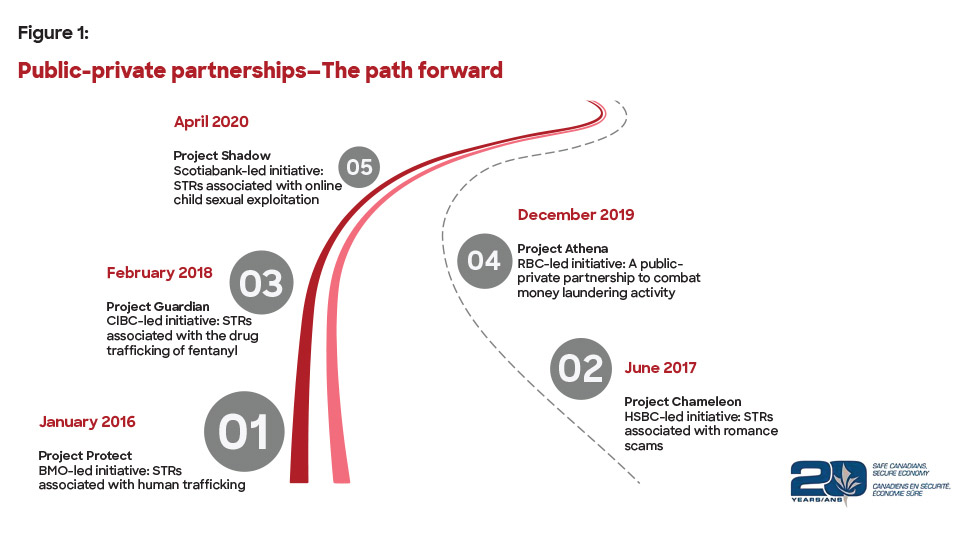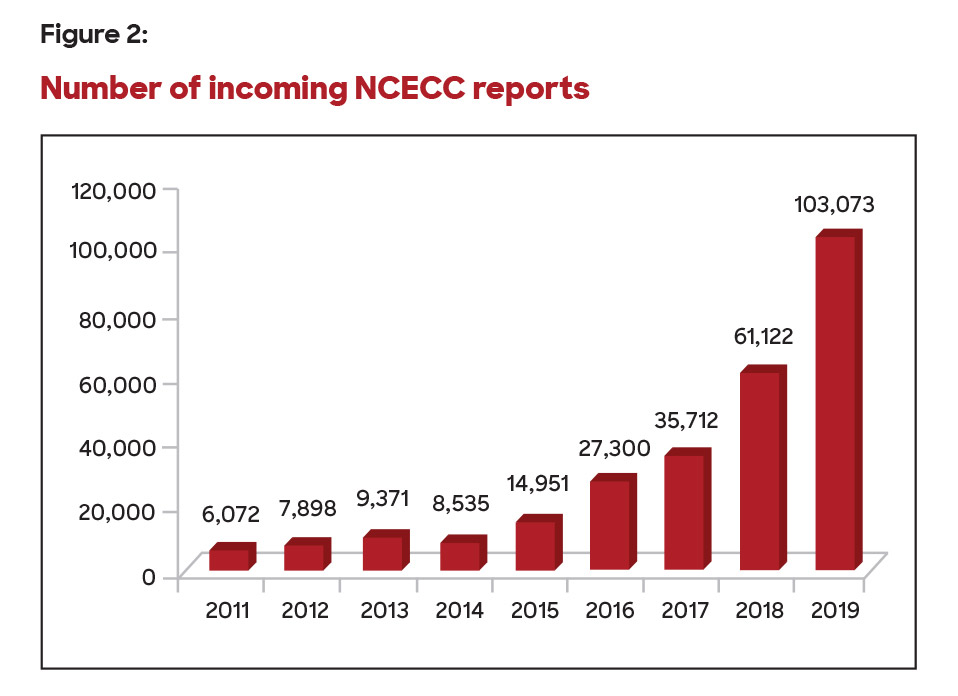
Project Shadow is a public-private partnership designed to combat online child sexual exploitation in all its forms by enhancing methods to detect, report and disrupt associated financial transactions suspected of being connected to money laundering in any and all of its stages (placement, layering and integration). The partnership is co-led by Scotiabank and the Canadian Centre for Child Protection and is supported by the Financial Transactions and Reports Analysis Centre of Canada (FINTRAC) with participation from major financial institutions and law enforcement agencies in Canada. This public-private partnership is the fifth to launch in as many years (see Figure 1), as the series first launched in 2016 with Project Protect. Stuart Davis, executive vice president and global head, financial crimes risk management at Scotiabank, said the following of the partnership:
“Scotiabank is pleased to be working with FINTRAC, the Centre and our industry peers in shining a spotlight on the dark nature of online child exploitation and its criminal use of the financial system. I believe our collective efforts to increase awareness, identify typologies and to facilitate reporting to law enforcement will make an immeasurable difference to those communities that we serve.”
Goals and Objectives
The goal of Project Shadow is to detect, report and disrupt the finances of online child sexual exploitation in all its forms. Specific objectives are listed as follows:
- Raise awareness of child exploitation amongst the financial crimes risk management and law enforcement professional community
- Identify red flag indicators and typologies related to money laundering at the placement, layering and integration stage
- Increase suspicious transaction reporting of associated financial transactions to Canada’s national financial intelligence unit, FINTRAC
- Establish a new suspicious transaction report (STR) code (Project Shadow/#SHADOW) to indicate potential online child sexual exploitation
- Contribute to the mainstreaming of financial investigations into online child sexual exploitation internationally
Barry MacKillop, deputy director of intelligence at FINTRAC, said the following of Project Shadow’s goals:
“Building on the continued success of public-private partnerships with our valued partners, Project Shadow aims to harness the power of financial intelligence to combat online child sexual exploitation. As Canada’s financial intelligence unit, FINTRAC is proud to help shed light on this predatory crime and bring it out of the shadows to protect the children of today and tomorrow.”
The Problem of Online Child Sexual Exploitation
The Virtual Global Taskforce, an international collaboration of law enforcement agencies, nongovernment organizations and industry partners to protect children from online and offline sexual exploitation, defines online sexual exploitation of children as, “offences related to possessing, distributing, producing and accessing child pornography [or, more accurately, child sexual abuse material or child sexual exploitation material], online grooming and luring.”11 This crime has seen a significant rise with the increased use of the internet, with an estimated 1.8 million new male internet users that have a sexual interest in children over the last year. This startling estimate of potential offenders is further supported by the growing number of child sexual abuse material (CSAM) reported online.2 In 2018, technology companies identified and reported 45 million instances of online videos and photos of children being abused, more than double that of the previous year, according to The New York Times.3 COVID-19 has confounded matters even further with Interpol stating that sharing CSAM through peer-to-peer (P2P) networks has increased during the pandemic while reporting of such instances is down.4 According to Lianna McDonald, executive director of the Canadian Centre for Child Protection,
“Every minute of every day, thousands of survivors of child sexual abuse are exploited online as offenders sell and trade the worst moments of their lives. Survivors need every single one of us in the battle against this horrific crime. Project Shadow is a new weapon against those profiting from the sexual exploitation of our most vulnerable, providing a critical insight into the complexity of the commercial nature of these crimes.”
Beneath this disturbing surge of CSAM, much of which is traded for sexual gratification, is a dark market of financially incentivized trade where individuals profit off CSAM abuse and/or facilitation. In 2019, global law enforcement took aim at a significant portion of this dark market with a large-scale international operation aimed at shuttering a website called Welcome to Video, the largest paid-access CSAM website identified to date.5 What made this case even more interesting was the use of bitcoin to make purchases on the website. This not only highlights the potential success of conducting bitcoin blockchain forensic investigations, it also further depicts the risks associated with virtual currencies due to their users’ perceived anonymity.
In Canada, the problem of online child exploitation mirrors the international issue in terms of scale. Statistics released from the Royal Canadian Mounted Police’s (RCMP) National Child Exploitation Crime Centre (NCECC) highlight significant growth in reported incidents of child exploitation from 2011 to 2019 (see Figure 2).
According to Marie-Claude Arsenault, chief/superintendent, officer in charge of the Sensitive and Specialized Investigative Services of the RCMP,
Unlike human trafficking for commercial sexual exploitation, the facilitation of online child exploitation is not primarily motivated by financial gain
“Online child sexual exploitation is an insidious and horrendous illegal act. The NCECC is fortunate to work with many dedicated partners to combat these crimes. Project Shadow is an initiative that helps us investigate child exploitation, hopefully leading to the identification and removal of victims from sexually [exploitative] environments, and enables us to bring those who commit these crimes to justice. We all must work together to fight online child sexual exploitation.”
Online Financial Indicators of Child Exploitation
Unlike human trafficking for commercial sexual exploitation, the facilitation of online child exploitation is not primarily motivated by financial gain. However, as mentioned earlier, there is a dark market that trades in related illicit material for both cash and virtual currencies, much of which passes through entities with a reporting obligation to their national FIU. This unfortunate but true reality―combined with the leveraging of reputable open-source internet research on convicted child exploiters―is what gave Project Shadow its foundation in identifying financial indicators associated with the creation, sale and distribution of online child sexual exploitation material.
By analyzing STRs submitted to FINTRAC that pertained to online child sexual exploitation, FINTRAC was able to identify indicators bucketed across three distinct categories of exploitation, those being the following:
- Money laundering indicators related to possible perpetrators who are consumers and/or facilitators of online child sexual exploitation
- Money laundering indicators related to possible perpetrators who are producers of online child sexual exploitation material
- Financial indicators possibly related to online child sexual exploitation in the form of luring
In addition to bucketing indicators of criminal offenses, FINTRAC also observed unique types and patterns of transactions, contextual factors and specific behavioral activity that further highlights the importance of knowing your client. While these indicators can be fairly ubiquitous on their own, considering several indicators during an investigation may reveal otherwise unknown links that may indicate a transaction is related to online child sexual exploitation offenses and/or the laundering of proceeds derived from those crimes. These high-level observations were also noted in Project Protect and while Project Protect is of a different scope, some indicators were found to overlap. However, the major difference between the indicators identified in Shadow versus those of Protect was that Shadow indicators heavily pertained to online activities and enabling those activities compared to Protect’s in-person touch points. FINTRAC assessed that perpetrators and suspected perpetrators of online child sexual exploitation, based on their financial transactions, likely spent a large portion of time on the internet.
Indicators identified via Project Shadow are listed below.
Money Laundering Indicators Related to Possible Perpetrators Who Are Consumers and/or Facilitators of Online Child Sexual Exploitation
- Payments to or funds received through or from payment processors, including ones that deal in virtual currencies
- Purchases on webcam/livestreaming platforms, including those for adult entertainment
- Purchases on dating platforms, particularly Asian dating websites or ones that also offer adult entertainment content (dating websites observed in FINTRAC’s analysis were: www.filipinocupid.com, www.asianbeauties.com, www.asiandating.com, www.asiandatingspace.com, www.asiandate.com, www.arabmatching.com, www.amolatina.com, www.lovetoria.com, www.naughtydate.com, www.mingle2.com, Tinder, Grindr)
- Purchases at adult entertainment venues and/or adult entertainment websites
- Payments to or purchases through a payment processor that specializes in serving high-risk merchants such as those in the adult entertainment industry—some of which appear able to conceal the merchant’s name
- Payments to a self-storage facility and/or for office rentals
- Purchases at multiple vendors of electronics, computers, and cell phones and/or payments to multiple cell phone service providers
- Purchases at a vendor that rents or leases computers and/or computer equipment
- Purchases at online gaming platforms and/or gaming stores
- Transactions to reload prepaid credit cards (particularly ones that deal with virtual currencies)
- Purchases at online merchants
- Purchases of gift cards and/or payments made using gift cards
- Payments to or purchases through social media platforms, including ones that enable payment services through a payment processor
- Email money transfers that include a partial email address or reference with terms possibly related to child sexual exploitation
- Use of virtual currencies to fund a virtual currency account, convert funds and/or transfer funds to another virtual currency wallet, obtain a cryptocurrency loan or withdraw funds in cash
Money Laundering Indicators Related to Possible Perpetrators Who Are Producers of Online Child Sexual Exploitation Material
- Purchases at vendors that offer software for P2P platforms for P2P sharing of videos and images, including software to share hard drive content directly over the internet
- Purchases at vendors that offer software for capturing video from websites or other online platforms
- Purchases at vendors that offer Voice-over-IP communication services
- Purchases at domain registration/website hosting entities
- Purchases at vendors specializing in equipment or software for photography or videomaking
- Purchases at creator-content streaming websites (e.g., membership fees or subscriptions to these sites or payment of funds to other streamers on these sites)
- Receiving funds from a payment processor and having a profile on a creator-content streaming website (particularly a creator-content website that includes adult entertainment content with a subscription-based channel model)
Financial Indicators Possibly Related to Online Child Sexual Exploitation in the Form of Luring
- Multiple purchases for accommodations (hotel/motel/peer-to-peer accommodation rentals), particularly at venues in the individual’s own city or in a nearby city
- Use of separate email accounts to send or receive email money transfers
- Email money transfers sent to multiple females including minors
- Purchases at youth-oriented stores or venues (e.g., toy stores, children’s clothing stores, amusement parks, candy shops)
- Purchases at vendors for cannabis/cannabis-related products and equipment and/or at pharmacies
- Payments to an online classified ad website
- Purchases at youth-oriented live online chat rooms
The operational alerts and complete list of indicators can be found on FINTRAC’s website.6
Early Impact
Since Project Shadow’s unofficial launch in January 2020, the project has generated over 100 STRs that have spurred more than 30 disclosures by FINTRAC to law enforcement agencies.7 In addition, stakeholders of the Project Shadow team have begun to engage with international organizations and institutions to collaborate on sharing best practices to combat online child exploitation. Engagements thus far include the U.S. Financial Coalition Against Child Sexual Exploitation,8 the WePROTECT Global Alliance9 and the Vatican’s Pontifical Academy of Science.10
Looking ahead
The Canadian approach to addressing complex and sensitive financial crimes, via public-private partnership, embarks into the decade ahead more focused than ever and the successful deployment of Project Shadow is a testament to this strength. Project Shadow takes aim at the finances of a horrendous crime by raising awareness, increasing intelligence and mainstreaming an approach toward financial investigations. In doing so, the project joins the ranks of similar efforts undertaken in 2020, such as the work done by Egmont Group11 and the United Kingdom’s financial intelligence unit the UKFIU,12 and hopefully many more to come.
Joseph Mari, director, Anti-Money Laundering Financial Intelligence Unit and External Partnerships, Financial Crimes Risk Management, Scotiabank
- “Combating online child sexual abuse, Virtual Global Taskforce,” Virtual Global Taskforce, http://virtualglobaltaskforce.com/
- Michael H. Keller and Gabriel J.X. Dance, “The Internet Is Overrun With Images of Child Sexual Abuse. What Went Wrong?” The New York Times, September 29, 2019, https://www.nytimes.com/interactive/2019/09/28/us/child-sex-abuse.html
- Ibid.
- “INTERPOL report highlights impact of COVID-19 on child sexual abuse,” Interpol, September 7, 2020, https://www.interpol.int/News-and-Events/News/2020/INTERPOL-report-highlights-impact-of-COVID-19-on-child-sexual-abuse
- “South Korean National and Hundreds of Others Charged Worldwide in the Takedown of the Largest Darknet Child Pornography Website, Which was Funded by Bitcoin,” The United States Department of Justice, October 16, 2019, https://www.justice.gov/opa/pr/south-korean-national-and-hundreds-others-charged-worldwide-takedown-largest-darknet-child
- “Strategic intelligence,” Financial Transactions and Reports Analysis Centre of Canada, https://www.fintrac-canafe.gc.ca/intel/sintel-eng
- “Five years of growth in public–private financial information-sharing partnerships to tackle crime,” Royal United Services Institute, https://www.gcffc.org/wp-content/uploads/2020/08/FFIS-Report-Five-Years-of-Growth-of-Public-Private-Partnerships-to-Fight-Financial-Crime-18-Aug-2020.pdf
- “U.S. Financial Coalition Against Child Sexual Exploitation,” International Centre for Missing & Exploited Children, https://www.icmec.org/fcacse/
- “The WePROTECT Global Alliance launches as an independent organisation,” WePROTECT Global Alliance, https://www.weprotect.org/
- “Promoting Digital Child Identity From Concept to Action, From 2017 to 2019” The Pontifical Academy of Social Sciences, November 14-15, 2019, http://www.pass.va/content/dam/scienzesociali/booklet/booklet_digitalchilddignity.pdf
- “Combatting child sexual abuse and exploitation,” Egmont Group, July 2020, https://egmontgroup.org/en/content/combatting-child-sexual-abuse-and-exploitation-iewg-project-report-now-available
- “SARs in Action Issue 6,” National Crime Agency, July 2020, https://nationalcrimeagency.gov.uk/who-we-are/publications/469-sars-in-action-july-2020/file












